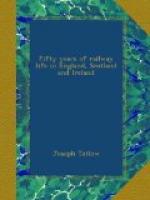Realm of enchantment, break your
mystic spell,
Land of the lotus, smiling land
farewell!
For ever it may be, what oracle
can tell?
CHAPTER XXVII. KING EDWARD, A CHANGE OF CHAIRMEN, AND MORE RAILWAY LEGISLATION
The memorable visit to Ireland of His Majesty King Edward, in the summer of 1903, which embraced all parts of the country, furnished I think no incident so unique as his reception in Connemara. On the morning of the 30th July the Royal Yacht anchored off Leenane, in Killery Bay, and His Majesty landed in Connaught. He was accompanied by Queen Alexandra and Princess Victoria. This was the first time, I believe, that the people west of the Shannon had seen their King, and whatever their politics, or aspirations were, he was certainly received with every manifestation of sincere good will. His genial personality and ingratiating bonhomie, his humanity, and his sportsmanlike characteristics, appealed at once to Irish instincts, and Connaught was as enthusiastic in its welcome as the rest of Ireland. The Royal party motored from Leenane to Recess, where they lunched at the Company’s hotel, and where, of course, the Chairman, directors and chief officers of the railway, as well as local magnates, were assembled to assist in the welcome. On nearing Recess a surprise awaited the King. He was met by the “Connemara Cavalry,” which escorted the Royal Party to the hotel and acted as bodyguard. Mr. John O’Loughlin, of Cashel, had organised this new and unexpected addition to His Majesty’s Forces. It consisted of about 100 farmers, farmer’s sons and labourers, of all ages from 18 to 80, mounted (mostly bareback) on hardy Connemara ponies. “Buffalo Bill” hats, decorated with the Royal colours or with green ribbon streamers, distinguished them from others. It was a striking scene, unexpected, novel, unique; but quite in harmony with the surroundings and the wild and romantic scenery of Connemara and the Killeries. The King plainly showed his hearty appreciation. After lunch their Majesties visited the marble quarries, situated some three miles distant, and reached by a rough and rocky precipitous mountain road, for which motor cars were entirely unsuited. For this journey the marble quarry people had ordered a carriage and horses from Dublin, but which, by some unfortunate occurrence, had not turned up. Though the only carriage available in the neighbourhood was ill-suited for royalty, the King and Queen, good naturedly, made little of that. They were too delighted with the unmistakable warmth of their welcome to mind such a trifle. Again the “Cavalry” were in attendance and escorted the party to the quarries and back.
The Royal visit to Ireland, on the whole, was an unqualified success, and there were many who hoped and believed that the King’s good will towards the country and its people, and his remarkable gifts as a peacemaker, would in some way help to a solution of the Irish question; but, alas! that question is with us still, and when and how it will be solved no man can tell. For myself, I am one of those who indulge in hope, remembering that Time, in his healing course, has a way of adjusting human misunderstandings and of bringing about the seemingly impossible.




